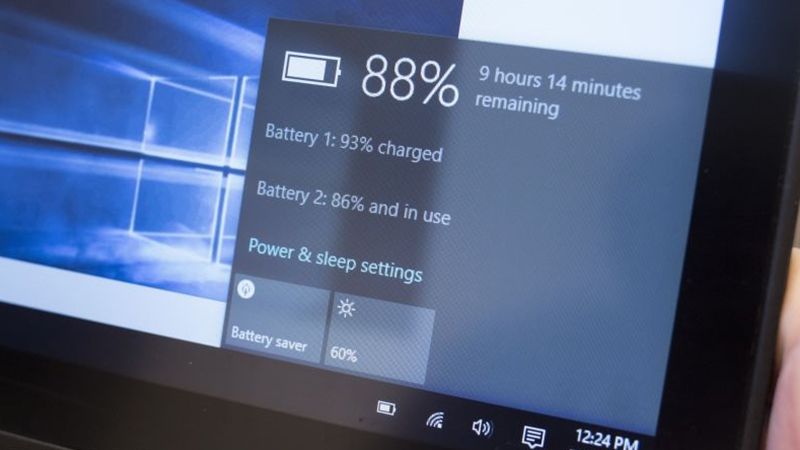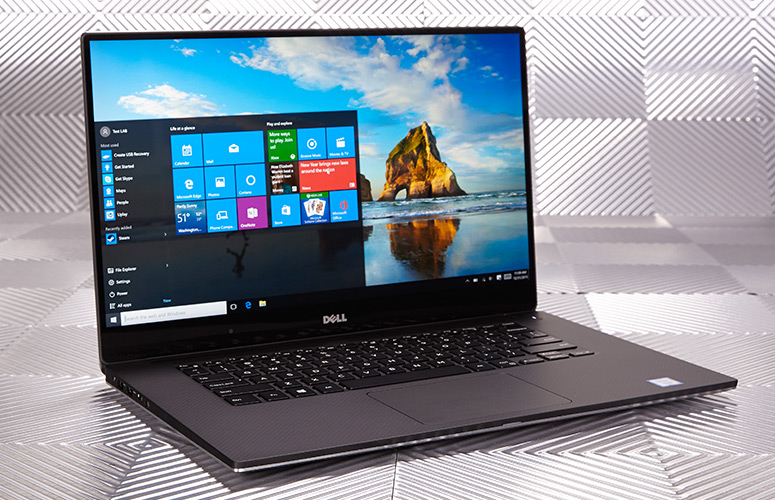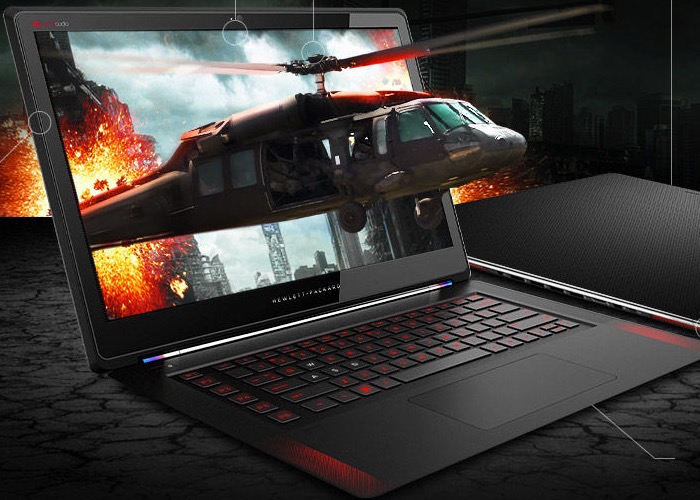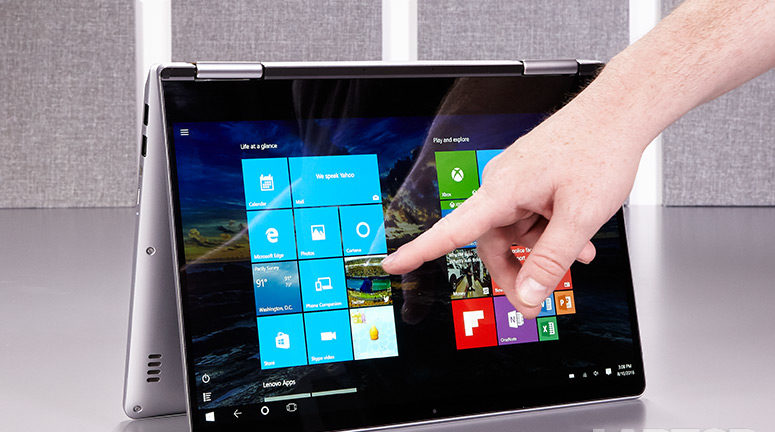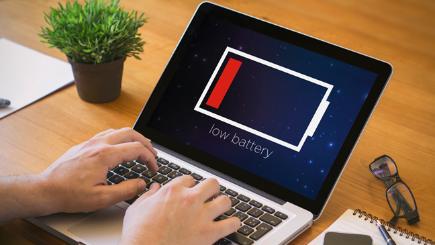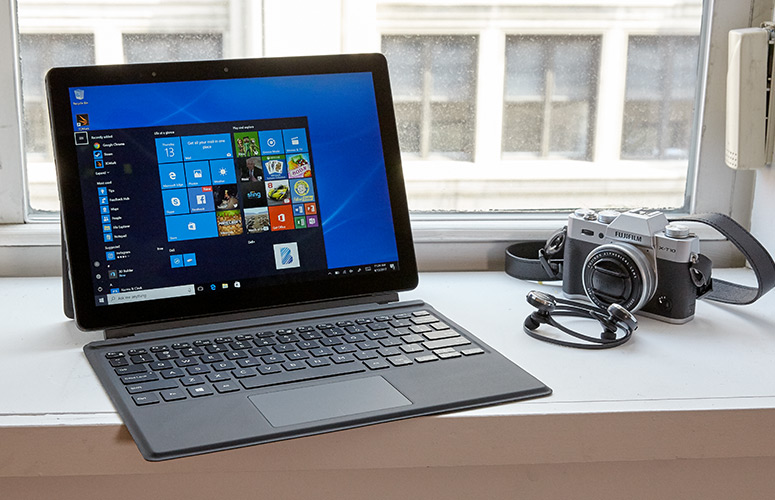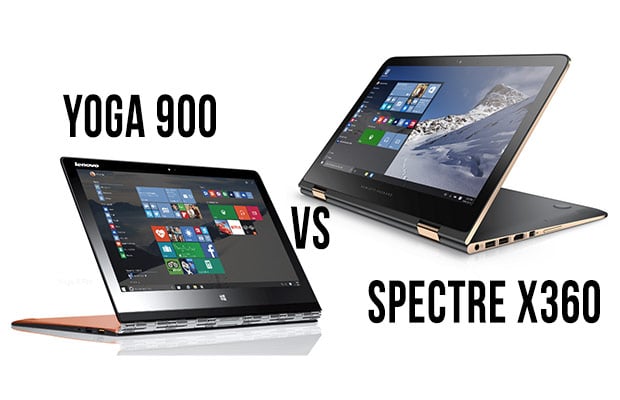How to Create a Detailed Laptop Battery Report in Windows 10
Windows 10 has a built-in, hidden battery reporting tool, it can tell you everything you need to know your laptop battery, including your battery life estimation and its capacity over time. Use this PowerCfg command to better understand your battery health and optimize the battery life of your computer.
We’ll use the command prompt to generate an HTML battery report for your computer.
1. Hit Windows Button + X and select Command Prompt (Admin). This is the quickest way to open the Command Prompt as an administrator.

This command will create a battery report under C:\WINDOWS\system32\battery-report.html or, in Windows versions older than Windows 10, under C:\Users\[Username]
3. Open the Battery report HTML file to view it.
The report will give you more information about the batteries in your system, as well as how they’ve been used over time.

Other report sections such as Usage history and battery capacity can help you check your laptop battery’s health. To get many more details about your battery than you from the battery icon in the taskbar, remember this hidden trick.
The Best After-Christmas Electronics Sales
Just because Christmas is over, it doesn’t mean you have to miss the holiday electronic trade. Big box stores and electronic powers are selling after Christmas in retail stores and online.
Many retailers offer deep discounts and clearance prices, along with extended store hours. Read on for some of the items to look for this year during these after-Christmas sales.
Amazon.com
Each year, Amazon promises the greatest post-holiday sales on a range of products, including electronics. During this year-end event you’ll find holiday clearance, overstocks, markdowns, and tech deals. Some of the items to look out for during after-Christmas sales online include:
- Anker PowerCore 10000: Never find yourself without a charge again. The Anker PowerCore 10000 is one of the smallest and lightest 10000mAh portable chargers, smaller than a deck of cards and as light as a baseball. This charger is great for airport commuters, providing almost three-and-a-half iPhone 6s charges or two-and-a-half Galaxy S6 charges. (Starting at $25.99 with free shipping)
- Otium Bluetooth Headphones: A favorite for athletes, sports competitors and those on the go, Otium’s Bluetooth headphones are great for running, jogging, hiking, biking or commuting. They offer a quick charge and up to eight hours of music streaming on a full battery. Enjoy a great price, one-year manufacturer’s warranty and a 30-day, no-questions-asked return policy. Reviewers called them “a terrific bang for the buck.” ($19.99 with free Amazon Prime shipping)
- Vakoo Kids Fun Shockproof iPad Case: If you share your iPad with little ones — or need highly durable protection for your device — a shockproof case is a valuable and economical investment. Vakoo’s Shockproof iPad case offers a built-in carry handle and is super durable. If you got an iPad for Christmas, consider this means of protection at a great deal. ($14.44 from Amazon Prime, was $16.99)
Target
Target is a constant favorite for gift card givers during the holiday season — and a good place to go for a day-after-Christmas sale. Pick up what you didn’t receive under the Christmas tree at great prices — a more budget-friendly alternative to the holiday rush. Some of the items to consider this year include:
- iRobot Roomba 860 Robotic Vacuum: Reviewers of iRobot’s Roomba say the vacuum is “the best thing to ever happen to our family.” The Roomba 860 works on all floor types and is just 3.6 inches tall, allowing it to fit under most furniture. ($349.99, regularly $499.99)
- Acer Chromebook 15: A perfect on-the-go computer, the Acer Chromebook 15 provides 12 hours of Acer as07b41 laptop battery life and runs on cloud-friendly Google Chrome OS. Fans of the Chromebook say it’s “much easier than trying to use my phone to play games or shop.” Look for Acer’s Chromebook at post-Christmas sales at Target. ($169.99, regularly $199.99)
- Google Home Mini: Powered by the Google Assistant, this compact, smart home device gives you hands-free access to your calendar, phone contacts, weather, music library and much more. Reviewers of the Google Home Minisay it is “space-saving and highly functional” and “well worth the price.” ($29.99, regularly $49.99)
Walmart
From stocking-stuffer electronics accessories to laptops and DVD players, Walmart will offer after Christmas deals for any budget. Some items to keep an eye out for include:
- Triple USB Universal Car Charger Adapter: This small-sized car charger adapter allows you to simultaneously charge three devices, using your existing USB charging cables, drawing on power directly from your vehicle’s ignition. ($5.84, list price $17.52)
- HP Silver Iridium Ci7 15.6-inch Laptop: Perhaps one of the most sought-after items for those looking for after Christmas laptop sales, HP’s Silver Iridium laptop is a great value. Reviewers of this laptop say “you can’t beat the price of this for all you get with it.” Enjoy a 15.6-inch diagonal screen, a seventh generation Intel Core Processor and Windows 10 Home.HP 593554-001 notebook battery life is up to nine hours and 15 minutes. ($699.00, was $760)
- Sylvania Compact DVD Player: Extremely affordable with a compact and sleek design, Sylvania’s Compact DVD player is compatible with DVD, VCD, CD-DA, CD-R/RW, MP3, HDCD, JPEG and Kodak Picture CD. Perfect for the Redbox or Netflix fan in your life, or a great option for a spare TV that’s not connected to cable or satellite. ($23.00, was $29.15)
Best Buy
Known for Cyber Week savings and hot deals on electronics, computers and appliances, you can get free shipping and fast store pickup at the Best Buy near you. Some of the best after-Christmas sales 2017 include:
- Samsung 50-inch LED Smart 4K Ultra HDTV: 4K resolution TVs offer clear, crisp, and sharp pictures with true-to-life picture. Smart TV technology provides quick access to streaming services, apps and live television. Reviewers say this Samsung 50-inch LED Smart 4K TV is “truly amazing.” ($479.99, was $699.99 — save even more with Open Box Deals)
- Insignia 32GB Tablet With Keyboard: Although Hybrid tablets are not new for 2017, the Insignia 32GB Tablet features plenty of internal memory, a detachable keyboard, and 2-megapixel front and rear cameras, with quad-core processor — all for less than $100. The tablet provides an affordable tablet option for surfing the internet, watching videos, and sending emails. ($89.99 was $129.99)
- Insignia 4-Port USB Charger Wall Outlet: Offered as a “Deal of the Day” during the 2017 holiday season, this handy Insignia 4-Port USB Wall Charger Outlet device allows you to turn any standard 120-volt outlet into an in-wall charging station, charging up to four electronic devices at once. This eliminates the need for bulky power strips and charging boxes. Reviewers of the outlet say it’s an “easy install” and “great way to declutter your countertop.” ($9.99, was $34.99)
Fry’s Electronics
Visit Fry’s Electronics website or one of the 34 US electronics superstores for after-Christmas deals such as:
- 9.7-inch 32GB iPad Pro w/ Wi-Fi + Cellular: You won’t find discounts the day after Christmas at Apple Stores. Fry’s offers the great savings on Apple products including the iPad Pro. Visit Frys.com and enter your ZIP code to view availability on the best prices and latest models of iPad. Bonus: Frys.com offers a price-match promise, matching prices from big-box stores and internet competitors. ($579, regularly $649)
Newegg
Newegg offers great deals on electronics, from hardware to entertainment. Check the site for after-Christmas deals at Black Friday prices on more than 10.5 million products.
- Xbox One S 500GB Console: The deal of the year, the Xbox One offers the best value in games and 4K entertainment. Newegg’s bundle includes the Xbox One S 500GB Console, one Xbox wireless controller with headset jack, 4K-capable HDMI cable, AC power cable, and a 14-day Xbox Live Gold trial. ($189.00, regularly $279.00)
After-Christmas sales offer extra discounts, last-chance savings and blowout prices, no matter what tech deals you are looking for. Give yourself the gift of a great deal by shopping at the best after-Christmas sale near you.
10 ideas for higher notebook battery life with Home windows 10
Does your laptop computer have you ever singing the short-battery-life blues? For those who have been updated to the Windows 10 autumn creators update, you must have bought a new software to help extend the running time of your laptop. I’m going to put this new software together with some real battery – saving ideas.
Flip down show brightness
Powering all of these pixels within the show is the one biggest drain on battery assets. The primary merchandise to test when you find yourself experiencing troublingly brief battery life is your show brightness. For those who’ve bought it turned up all the best way or close to the max, then decrease the brightness; you may additionally discover it a extra snug computing expertise to your eyes.
Your laptop computer seemingly has two Perform keys mapped to show brightness. If not, you could find a brightness slider by going to Settings > System > Show. You may additionally discover a slider for show brightness within the Home windows Mobility Heart, which is buried within the Management Panel; the simplest strategy to discover it’s simply to seek for it.
Paint it black
A vivid desktop background requires your show’s pixels to mild up extra, when requires extra juice. Select a darkish image or shade by going to Settings > Personalization > Background.
Flip off keyboard backlights
Just like the show, keyboard backlighting additionally drains your laptop computer’s battery. Flip them off after they aren’t wanted. Your laptop computer seemingly has a Perform key that allows you to toggle the keyboard backlights on and off. If not, you may discover a management for it within the Home windows Mobility Heart.
Introducing the brand new battery slider
OK, now here is the brand new battery software. Fall Creators Replace has made it simpler to change between energy modes. As an alternative of digging into the battery web page in settings to change from excessive efficiency to battery saver mode or vice versa, you now can simply click on or faucet the battery icon within the taskbar. You can transfer a slider from Finest battery life to greatest efficiency or a balanced mode in between.
Examine energy and sleep settings
Dig into Energy & sleep settings by clicking its hyperlink within the battery menu from the taskbar (or by going to Settings > System > Energy & sleep), and you may shorten the time earlier than the show turns off or your laptop computer goes into sleep mode when it is operating on battery energy. The shorter you set these occasions, the longer your Dell studio 1537 laptop battery will final.
Use Battery Saver
Home windows 10’s built-in Battery Saver mode prompts when your remaining battery dips beneath 20 p.c. It disables electronic mail and calendar syncing, push notifications, and apps from operating within the background. It needs to be enabled by default, however test to ensure it’s by going to Settings > System > Battery. For those who discover that Battery Saver would not disrupt your common Home windows habits, then you possibly can elevate the brink for when it prompts above 20 p.c.
Examine Battery utilization by app
You may see which apps are utilizing essentially the most battery assets by Settings > System > Batteryand click on Battery utilization by app. The record will present you the share of battery your apps have used prior to now 6 or 24 hours or the previous week. For those who discover an app that you just assume it utilizing greater than its fair proportion, click on on it and toggle off the change for Managed by Home windows after which ensure that the field stays unchecked for Permit app to run background duties.
Flip off Bluetooth and Wi-Fi when not wanted
These wi-fi networking applied sciences devour battery energy. You may disable each by utilizing Airplane mode. Click on the Wi-Fi icon within the taskbar after which click on the Airplane mode button. You too can disable solely Wi-Fi by clicking the Wi-Fi button on the taskbar Wi-Fi menu. To disable Bluetooth, go to Settings > Gadgets > Bluetooth & different units and toggle off the change for Bluetooth.
Sync electronic mail much less
Continuously checking for brand new electronic mail messages can drain your battery. So, inform Home windows to test much less incessantly to increase the lifetime of your battery. Go to Settings > Accounts > E-mail & app accounts. Click on in your account, click on the Handle button after which for Obtain new content material, change it from as gadgets arrive to each 30 minutes, hourly or manually after which click on Carried out.
Help Me, Notebook: I Need a Lightweight Gaming Rig on a Budget
It’s hard to game on a budget. Games require powerful GPUs that are expensive and bulky. But forum user ws479099412 is willing to compromise power if they can get a good price.
They asked for a recommendation on a laptop that costs less than $1,000, weighs under 5 pounds and can be used for gaming. They already conceded that they may have to give up on getting an Nvidia GeForce GTX 1050 GPU in favor of a light workstation card like an MX150 to get that size. We wouldn’t do that personally, but hey, who are we to judge?
Fortunately, there are a few options out there for ws479099412, some of which sell for way cheaper than $1,000. However, I think spending the most you can will get you more gaming performance in the long run.
What are the best options? Let’s dig in:
Lenovo Yoga 720
After a bunch of searching, I think the ideal computer for ws497008412 is the Lenovo Yoga 720. It starts at $950 and weighs 4.6 pounds. While that’s heavy for a 2-in-1, it’s still below ws479099412’s weight requirement. But most importantly, this laptop has an Nvidia GeForce GTX 1050 GPU, which will play most games, though not at the highest settings.
The 15.6-inch, 1080p display is bright and vivid, though the base model comes with only 256GB of SSD storage, so you’ll want an external hard drive to hold your Steam library. The other base-model specs include 8GB of RAM and an Intel Core i5-7300HQ CPU.
Acer Nitro 5 Spin
Ws479099412 mentioned that they were looking into the Acer Nitro 5 Spin, and it seems like a great choice. The caveat here is that we haven’t had the opportunity to review that machine, so I can’t vouch for it. The Nitro costs $949 and comes with a GTX 1050, a 15.6-inch display, 8GB of RAM and an 8th-Gen Intel Core i7 CPU.
That’s a newer processor than the Yoga has, which is nice, though most games are GPU-bound, so you shouldn’t see a huge difference when gaming. The Nitro weighs 4.9 pounds, so it’s just under ws479099412’s weight limit.
Acer Aspire E15 (E5-576G-5762)
If you’re looking to save money and don’t care about how your games look, I don’t understand you, but I have an option for you. This Acer Aspire E15 (E5-576G-5762) is just $599 and comes with an Intel Core i5-8250U CPU, 8GB of RAM,a good longer ACER Aspire 5513WLMi Laptop Battery,a 256GB SSD and an Nvidia MX150 GPU.
That GPU won’t touch the GTX 1050, but it should be fine for less-intensive games, like Overwatch and World of Warcraft. Most games won’t look great on this machine, though, and if you’re serious about gaming, you’ll consider a laptop with at least a GTX 1050.
Best 2-in-1s Laptop/Tablet Hybrids of 2018
If you want a notebook to be the most common one, bending back or switching to flat mode is your best choice. We listed our favorite 2 and 1 below, here there are three things you need to remember when shopping.
- Bendback or Detachable?: Bendback 2-in-1s, which have screens that flip back 360 degrees, work far better in laptop mode and usually have greater endurance, a better keyboard and more ports. Detachable 2-in-1s, which have screens that pop off, provide a better best tablet experience.
- Screen Resolution: While some cheaper models will have 1366 x 768 resolutions, try to get at least a 1920 x 1080 display.
- Size: For the best balance between portability and usability, consider a 2-in-1 with a 12 or 13-inch display and a weight less than 3.5 pounds. Smaller laptops are great for kids while 15 and 17-inch models provide lots of real estate for drawing or media viewing.
10 tips for better notebook battery life with Windows 10
Does your laptop have a short battery life blues? If you have updated the Windows 10 for the fall creator update, then you have a new tool to help extend the running time of your laptop. I’ll introduce this new tool and some real battery saving techniques.
Turn down display brightness
Powering all of those pixels in the display is the single greatest drain on battery resources. The first item to check when you are experiencing troublingly short battery life is your display brightness. If you’ve got it turned up all the way or near the max, then lower the brightness; you might also find it a more comfortable computing experience to your eyes.
Your laptop likely has two Function keys mapped to display brightness. If not, you can find a brightness slider by going to Settings > System > Display. You’ll also find a slider for display brightness in the Windows Mobility Center, which is buried in the Control Panel; the easiest way to find it is just to search for it.
Paint it black
A bright desktop background requires your display’s pixels to light up more, when requires more juice. Choose a dark picture or color by going to Settings > Personalization > Background.
Turn off keyboard backlights
Like the display, keyboard backlighting also drains your Hp pavilion dm4 laptop battery. Turn them off when they aren’t needed. Your laptop likely has a Function key that lets you toggle the keyboard backlights on and off. If not, you’ll find a control for it in the Windows Mobility Center.
Introducing the new battery slider
OK, now here’s the new battery tool. Fall Creators Update has made it easier to switch between power modes. Instead of digging into the battery page in settings to switch from high performance to battery saver mode or vice versa, you now can just click or tap the battery icon in the taskbar. You’ll be able to move a slider from Best battery life to best performance or a balanced mode in between.
Check power and sleep settings
Dig into Power & sleep settings by clicking its link in the battery menu from the taskbar (or by going to Settings > System > Power & sleep), and you can shorten the time before the display turns off or your laptop goes into sleep mode when it’s running on battery power. The shorter you set these times, the longer your battery will last.
Use Battery Saver
Windows 10’s built-in Battery Saver mode activates when your remaining battery dips below 20 percent. It disables email and calendar syncing, push notifications, and apps from running in the background. It should be enabled by default, but check to make sure it is by going to Settings > System > Battery. If you find that Battery Saver doesn’t disrupt your regular Windows habits, then you can raise the threshold for when it activates above 20 percent.
Check Battery usage by app
You can see which apps are using the most battery resources by Settings > System > Battery and click Battery usage by app. The list will show you the percentage of battery your apps have used in the past 6 or 24 hours or the past week. If you find an app that you think it using more than its fair share, click on it and toggle off the switch for Managed by Windows and then make sure the box remains unchecked for Allow app to run background tasks.
Turn off Bluetooth and Wi-Fi when not needed
These wireless networking technologies consume power. You can disable both by using Airplane mode. Click the Wi-Fi icon in the taskbar and then click the Airplane mode button. You can also disable only Wi-Fi by clicking the Wi-Fi button on the taskbar Wi-Fi menu. To disable Bluetooth, go to Settings > Devices > Bluetooth & other devices and toggle off the switch for Bluetooth.
Sync email less
Constantly checking for new email messages can drain your battery. So, tell Windows to check less frequently to extend the life of your battery. Go to Settings > Accounts > Email & app accounts. Click on your account, click the Managebutton and then for Download new content, switch it from as items arrive to every 30 minutes, hourly or manually and then click Done.
Magid: An HP notebook that’s also a tablet and doesn’t weigh you down
In June 2010, I participated in the “full digital” conference of the Wall Street journal. Steve Jobs said, “when we are an agricultural country, all cars are trucks. But as people move to the center of the city, people start to enter the car. I think the personal computer will be like a truck. Fewer people need them.
I was also present in April of that year when Jobs announced the iPad, and at the time, I called it “underwhelming.” Yes, I was impressed by the achievement, but I declared the device “too big to put in your pocket but not as easy to type on as a laptop.” For a while, the market proved me wrong. Early sales of iPads were impressive, but around 2015, we started to see the tablet market shrink.
A few years after Apple launched the iPad, tablets started losing market share, getting pressure from both sides. Laptops started to get smaller and more versatile and smartphones got larger. Even though I have purchased several tablets over the years from Apple, Amazon and various Android vendors, mine all sit in a drawer or have been donated to schools. That’s because my smartphone is now large enough to read ebooks and watch video, and it’s even big enough for a reasonably OK on-screen keyboard. But it’s also because laptops have shrunk in size and weight. Plus, if I really want to use a device in “tablet mode,” the laptop I’m carrying can accommodate that.
I’m currently testing the HP 12-inch EliteBook x360 1020 G2 “convertible” or “two-in-one” device, which, like Lenovo’s Yoga line, has a screen that can also be used in tablet mode. Actually, it can be positioned at any angle so it can also be tentlike to sit on a table or positioned so that the keyboard faces down. Microsoft Surface PCs are also convertible, but their keyboards snap on and off so you can leave them at home if you want. As someone who does a lot of typing and rarely needs a tablet, I prefer the HP and Lenovo strategy.
The HP model I’m testing weighs 2.5 pounds (weight can vary by configuration and components), which is 1.3 pounds heavier than the first iPad. But even iPads have evolved into PCs. Apple now offers an optional keyboard for it iPad Pro, which turns it into a laptop that runs iOS. There are plenty of third-party keyboards for other iPads as well as Android tablets.
The new HP notebook shares another trait with tablets — its Hp pavilion dv7 notebook battery lasts all day. HP rates it for 15 hours, but like EPA mileage estimates, your experience will vary. Mine is never as good as what the manufacturer claims, partially because I use some energy-guzzling software, and I like a bright screen. But even if I only get 10 hours of battery life, that’s still enough to leave the power supply at home. And speaking of that, having a 2.5-pound laptop in my backpack is relatively easy on my back, which I will appreciate next month when I’m carrying it around during my five days at the CES trade show in Las Vegas. HP says that you can get a 50 percent charge in 30 minutes.
HP offers several versions of its EliteBooks. The one I’m testing comes with 8 gigabytes of memory and 256 GB of storage
It also comes with a pen (which I’ve already misplaced) that lets you draw on the screen. I wish there were a storage slot for that pen, but that might have made it harder to keep the device as thin (about a half an inch) as it is. There are two USB C ports and an HDMI port for a TV or monitor. I’d be happier if it came with a standard USB A port, but that was jettisoned to keep the device smaller. There are adapters for less than $5 that easily attach to any USB device. Unlike new iPhones and some Android phones, there is a standard headphone/microphone jack. Like many new phones, you can unlock it with a fingerprint. And unlike any MacBook, it has a touch screen, which I find more useful than I had imagined.
The EliteBook that I’m testing sells for $1,599 but you can pay less or more, depending on storage and other features. Some models come with HP Sure View, which is a built-in privacy screen that’s activated by a key press. The model I’m testing has a full high-definition screen, but you can get them with ultra-high definition (UHD) for those who care about the highest possible resolution. Aside from costing more, both Sure View and UHD use more energy, so I’d rather have more Hp elitebook 8530w laptop battery life and a few extra dollars in my pocket.
HP also has other models including a 13-inch 1030 series and the 14-inch 1040 series that are similarly priced, with varying features. Unlike smartphones, bigger isn’t necessarily more expensive when it comes to laptops. For some people, “less is more,” when it comes to size and weight.
I can’t help but think about that Steve Jobs quote about cars vs. trucks. If a laptop is a “truck,” then I guess I’m a PC driver. But like millions of people who drive pick-up trucks, I prefer laptops that are small, light, rugged, versatile and energy-efficient that can be used for work and play.
Make 10 cordless drills for yourself
In a walkway for a family center cruise tool, not to mention an innumerable online route, you’ll find a series of cordless drills. CR is here to help reduce your choice to more than 30 models, which we recently bought and tested for beginners.
We perform the bulk of our tests on a benchtop instrument called a dynamometer. It measures torque under different loads that we use to derive scores for power, speed, and run time. To give you a sense of what’s involved in our drill reviews, CR engineers could drive 67,547 wood screws into pine boards for the total work they measured during testing. (They use 1½-inch-long #8 screws.)
Check out our cordless drill ratings for detailed results of all that effort. There you’ll find models from contractor favorites DeWalt, Makita, and Milwaukee, as well as brands for the average homeowner: Black+Decker, GreenWorks, Hitachi, Panasonic, Porter-Cable, Ridgid, Skil, and Worx. We also tested the brands Kobalt (Lowe’s) and Ryobi (The Home Depot).
Here are 10 models for the dedicated DIYer, from weekend warrior to future master carpenter. They’re broken down into three categories—general use, heavy-duty, and light-duty—and listed alphabetically, not by CR rank.
Visit Consumer Reports’ 2017 Holiday Gift Guide for updates on deals, expert product reviews, insider tips on shopping, and much more. And be sure to check our Daily Gift Guide.
Bosch PS32-02
CR’s take: One of only two brushless models in our general use category, this Bosch delivers solid performance at under 2 pounds, less than half the weight of a number of heavy-duty drills we tested. The slim, pistol-grip profile makes this 12-volt model comfortable to handle, and the downsized package still accommodates features like a built-in LED light and bit storage. If you’re upgrading from an old 18-volt drill and don’t find yourself doing lots of heavy-duty work with your drill, this is a well-rounded option.
What’s included: Two 2.0 Ah batteries, five bits, and a soft-sided case
Makita FD07R1
CR’s take: This brushless Makita weighs just over two pounds and stands barely 6-inches tall. Despite its slim profile, the Makita packs a serious punch, making it a solid alternative to some of the larger, 18 and 20-volt models. It comes with two batteries and a rapid charger, which tops off an empty battery in an impressive 60 minutes, so you’ll never be without a drill. Also nice, the MAKITA 9122 Power Tool Battery mounts to the bottom of the drill, so unlike the Bosch, it stands upright.
What’s included: Two 2.0 amp-hour (Ah) batteries and a reversible Phillips/flat-head bit
Ridgid R82005K
CR’s take: If you don’t harbor a lust for power tools but recognize that you need a drill of some sort, this is the one to buy. For $100, you get everything you need and nothing you don’t. Like the 12-volt Bosch above, this model has a pistol-grip profile, making it both comfortable and small enough to toss in the junk drawer. Plus it comes with a 3-year warranty for the tool itself as well as the battery. That’s among the longest for drills in our ratings.
What’s included: Two 1.5 AH batteries
Black+Decker BDCDDBT120C
CR’s take: This bargain-priced drill has a big 20-volt battery that seems like a mismatch for its small ⅜-inch chuck and lightweight 2.5-pound body. It’s half the weight of some of the largest 20-volt tools in our ratings—good for handling but perhaps not so terrific for power. It comes with a lone battery that takes nearly 4 hours to charge vs. only 30 minutes for some other models in our ratings.
What’s included: One 2.0 amp-hour (Ah) battery and a reversible Phillips/flat-head bit
DeWalt DCD791D2
CR’s take: This 20-volt drill from DeWalt (featured in the video above) is neither as brawny as the biggest 18-volt drills we tested nor as balanced as the best 12-volts. But by splitting the difference between those extremes, this model may be the Goldilocks of cordless drills for some users. That means compact enough that you won’t tire from using it to swap out an overhead light fixture but forceful enough to bore holes in hardwood without bogging down. It’s well worth considering if you’re torn between voltage ratings.
What’s included: Two 2.0 Ah DEWALT DC9071 Power Tool Batteries and a hard-sided case
Kobalt (Lowe’s) KDD 1424A-03
CR’s take: Exclusive to Lowe’s, this 4-pound bruiser is a whole lot of drill for the money. One way Kobalt keeps costs down is by giving you only one battery, albeit a big 24-volt unit. Consider buying a second ($50) for larger projects and always keeping one on the charger. This model will drill plenty of holes fast and perform well enough to serve as a tackle-any-task option for the average homeowner.
What’s included: One 2.0 Ah battery, a removable side grip, a single Phillips bit, and a hard-sided case
Milwaukee 2705-22
CR’s take: By pairing a powerful, brushless motor with a giant 5.0 Ah battery, this drill leaves you feeling like you could build a deck in an afternoon. If you tried, there’s little doubt the drill could keep up. That ginormous battery makes the drill heavy; at 4.65 pounds, it’s more than double the weight of some stellar 12-volt models CR tested. And with so much of the weight concentrated in the battery, which snaps onto the base of the handle, it can feel unbalanced. The clutch has 14 settings, so you can dial back the beast for more delicate tasks such as tightening a cabinet pull. Of course, if that’s all you’re doing, a screwdriver will work just fine.
What’s included: Two 5.0 Ah batteries, a removable side grip, and a hard-sided case
Ridgid R86116K
CR’s take: If you don’t mind working with a drill on the bulkier end of the spectrum, you may want to check out this model, because it’s the only tool in our ratings with a built-in hammer-drill setting. That’s a handy function for projects like drilling into masonry—think fastening a ledger board to the foundation of your house to build a deck. (If you don’t know what a ledger board is, then you probably don’t need this drill.) The Ridgid also has an astonishing 115 clutch settings, which allow for precise control when driving screws. And it’s quick if not quite as powerful as the very best drills in our ratings.
What’s included: Two 2.0 Ah batteries and a hard-sided case
Ryobi P1811
CR’s take: Ryobi is a brand sold exclusively at Home Depot. This drill, like many of the brand’s offerings, provides quite a bit for the money, including a charger and two 18-volt batteries. The batteries also power an exceptionally broad slew of tools, including the traditional power tools you might expect, like a circular saw, impact driver, and worklight, as well as some unique offerings like an electric air inflator, pruning shears, and even a leaf blower.
What’s included: Two 2.0 Ah batteries and a soft-sided case
Worx WX176L
CR’s take: This unique drill falls in our light-duty category because of the limitations of its fixed, ¼-inch chuck. But it blurs the lines because it’s powered by a 20-volt battery, which would otherwise place it in the heavy-duty class. It’s a one-off design with two chucks, allowing you to load two different bits at once and easily switch from drilling to driving by rotating the wheel at the business end of the tool. The dual chuck might be more of a liability than an asset for some. The mechanism makes the tool a little unwieldy and hard to maneuver in tight spaces—say, inside a sink cabinet—which is why you’d want a light-duty drill in the first place.
What’s included: Two 1.5 Ah batteries, a single Phillips bit, and a soft-sided case
Lenovo Yoga 920 vs. HP Spectre x360: Who Wins
When it comes to choosing a fantastic two-in-one transformation, the two best options are Lenovo’s Yoga 920 and HP’s Spectre X360. it’s not a simple choice. Because both phones are the 8th Intel CPU and weigh about 3 pounds, but there are some important differences between the two machines.
To help you pick the best 2-in-1, we compared the Yoga 920 and the Spectre x360 side by side in several categories, including design, display, performance, battery life and value. And Lenovo’s sleek system has the edge.
Update Dec. 18 at 5:01 pm: This face-off is based on a version of the HP Spectre x360 with a Sure View privacy screen, which has an impact on Hp pavilion dv6 laptop battery life. We will update this comparison once we’ve had a chance to review the non-Sure View version of the Spectre x360.
| Lenovo Yoga 920 | HP Spectre x360 | |
| Starting Price | $1,099 | $999 |
| Price As Reviewed | $1,099 | $1,309 |
| CPU | 8th-Gen Intel Core i5, i7 | 8th-Gen Intel Core i5, i7 |
| GPU | Intel UHD 620 (Integrated) | Intel UHD 620 (Integrated) |
| Display | 13.9-inch, 1920 x 1080 | 13.3-inch, 1920 x 1080 / 3840 x 2160 |
| Ports | 1 USB 3.0, 2 Thunderbolt, fingerprint reader, headphone jack | 1 USB 3.0, 2 Thunderbolt, fingerprint reader, headphone jack, microSD memory reader |
| Battery Life | 12 hours and 22 minutes | 8 hours and 26 minutes |
| Size | 12.7 x 8.8 x 0.6 inches | 12 x 8.6 x 0.5 inches |
| Weight | 3.1 pounds | 2.9 pounds |
Design
The Lenovo Yoga 920 (12.7 x 8.8 x 0.6 inches, 3.1 pounds) is a bit larger and heavier than the HP Spectre x360 (12 x 8.6 x 0.5 inches, 2.9 pounds), but that’s actually an impressive feat for the 13.9-inch Yoga 920, which gives you a larger screen than the 13.3-inch Spectre.
The Spectre x360 comes in three colors: Natural Silver, Dark Ash Silver with Copper Luxe and Pale Rose Gold. The Yoga 920 also comes in a trio of hues: Bronze, Copper and Platinum.
If you want to use the fingerprint sensor in multiple modes, the Spectre x360 has an advantage, as its reader is embedded in the power button. The fingerprint sensor on the Yoga 920 is on the deck beneath the keyboard. However, not everyone wants to reach around to the side of the system when in laptop mode to use the reader.
The Yoga sports a slick, watchband-style hinge, while the Spectre has a pretty basic — but shiny — pair of hinges. Overall, we prefer the look and feel of the Yoga 920, and the fact that it gives you a slightly larger screen for not much more weight.
Winner: Yoga 920.
Ports
When it comes to ports, the Spectre x360 and Yoga 920 are nearly identical.
Both offer dual Thunderbolt 3 ports, a Type-A USB 3 port, a headphone jack and a fingerprint reader. The Spectre x360 sneaks out a win here, though, by offering a microSD memory reader.
Winner: Spectre x360.
Display
Both of these convertibles feature colorful displays, but one is brighter. That’s the Yoga 920, which packs a nearly bezel-free 13.9-inch display that comes in 1920 x 1080 and 3840 x 2160 resolutions, produces 105 percent of the sRGB color gamut and emits up to 284 nits of brightness.
The Spectre x360, on the other hand, produces 109 percent of the sRGB spectrum and emits a dimmer 261 nits of brightness. Nor can the Spectre match the Yoga’s viewing angles; colors on the Spectre darkened at 45 degrees to the left and right, while the Yoga’s screen stayed strong at 60 degrees in each direction.
HP also offers an optional privacy-screen technology upgrade called Sure View that makes it harder for others to peep over your shoulder. It costs $60 extra.
Winner: Yoga 920.
Keyboard
Both theYoga 920 and the Spectre x360 offer OK typing experiences, but neither keyboard stands out. Both feature a slightly shallow 1.3 millimeters of travel and try to make up for this by offering a higher actuation-force requirement than the 60-gram minimum we look for. The Spectre x360 registered 80 grams, while the Yoga 920’s keys require 68 grams.
Winner: Draw.
Performance
Both the Spectre x360 and the Yoga 920 can be configured with fast and capable 8th-Generation Intel Core processors. The Spectre x360 (Core i7-8550U CPU, 16GB of RAM) notched a strong 13,568 on the Geekbench 4 general performance test, while the Yoga 920 (Core i7-8550U, 8GB) we reviewed was close behind, scoring 13,306.
The Spectre x360’s fast 512GB M.2 PCIe NVMe solid-state drive notched a 566-MBps speed on our file-copy test. That’s nearly twice as fast as the 300 MBps from the Yoga 920’s 256GB NVMe PCIe SSD.
The Yoga 920 got a win in our OpenOffice macro test, where it matched 20,000 names and addresses in 3 minutes and 17 seconds, which is 6 seconds less than the 3:23 from the Spectre x360.
We also saw mixed scores in gaming tests, though both units include the same Intel UHD Graphics 620 chip. Both laptops ran the Dirt 3 racing game above our 30-frame- per-second playability threshold, but the Spectre x360 was smoother (56 fps) than the Yoga 920 (35 fps). The Yoga 920 earned 86,267 on the 3DMark Ice Storm Unlimited graphics benchmark, clearing the Spectre x360’s score of 79,528.
Winner: Draw.
Battery Life
The Yoga 920 offers enough Lenovo e390 battery life to leave your charger at home, even on longer days.
It lasted 12 hours and 22 minutes on the Laptop Mag Battery Test, which involves continuous web surfing over Wi-Fi. The Spectre x360 lasted 8:26, which is nearly 4 hours less. However, this was with the Sure View privacy screen, and we expect better results without Sure View.
Winner: Yoga 920.
Value
When configured with matching specs, the Spectre x360 repeatedly comes in at lower prices. So while you’ll pay $1,179 for a Spectre with a Core i7-8550U CPU, 8GB of RAM and a 512GB SSD, the Yoga 920 with those specs costs $120 more, at $1,299.
The more affordable Spectre x360 costs $999 and packs a Core i5-8250U processor, 8GB of RAM and a 256GB SSD, while a Yoga 920 with the same specs costs $1,199.40.
Winner: Spectre x360.
Overall Winner: Yoga 920
| Lenovo Yoga 920 | HP Spectre x360 | |
| Design | ✓ | |
| Ports | ✓ | |
| Display | ✓ | |
| Keyboard | ✓ | ✓ |
| Performance | ✓ | ✓ |
| Battery Life | ✓ | |
| Value | ✓ | |
| Overall Score | 5 | 4 |
Yes, this was a close fight, but the Yoga 920’s superior battery life and more attractive design put it over the top. Sure, it costs a bit more, but we’d happily pay that slight premium for a longer-lasting 2-in-1, especially when the performance is comparable to that of the Spectre x360 and you get a slightly bigger screen.
If budget is your deciding factor, you have a good reason to go with the HP Spectre x360, which still offers a lot of speed and gives you a microSD card slot. But the best 2-in-1 for our money is the Lenovo Yoga 920.
Which Asus Gaming Notebook Is Right for You?
Asus’ Republic of Gamers (ROG) line is wide-ranging,, and provides players with screen size, portability and price at each level. So which one is the best for you? Is a 15.6 inch light machine designed by a maximum dynamic pressure head? The 17 inch green giant with a 144 Hertz screen? The budget machine or the super expensive machine? The following is how to break the player’s lineup in the Republic.
3 Top Asus Laptops
| Asus ROG Strix GL753 | Asus ROG G701VI | Asus ROG Zephyrus (GX501) | |
| Starting Price | $1,099 | $2,999 | $2,299 |
| CPU | Intel Core i7-7700HQ | Intel Core i7-7820HK | Intel Core i7-7700HQ |
| GPU | Nvidia GeForce GTX 1050 Ti (4GB) | Nvidia GeForce GTX 1080 GPU (8GB) | Nvidia GeForce GTX 1080 Max-Q (8GB) |
| Display | 17.3-inches, 1920 x 1080 | 17.3-inch, 1920 x 1080, G-Sync | 15.6-inch, 1920 x 1080, G-Sync |
| Storage | 1TB HDD + 256GB SSD | Two 512GB PCIe m.2 SSDs in RAID 0 | 512GB PCIe SSD |
| RAM | 16GB | 64GB | 24GB |
| Size | 16.3 x 10.7 x 1.3 inches | 16.9 x 12.2 x 1.3 inches | 14.9 x 10.3 x 0.7 inches |
| Weight | 6.4 pounds | 7.9 pounds | 5 pounds |
| Battery Life | 5:25 | 3:27 | 0.08125 |
ROG vs. ROG Strix
Asus divides its gaming offerings into two lineups: ROG and a subbrand, ROG Strix. The Strix brand first appeared in 2014 as part of Asus’ graphics cards and headset product lines that target “performance-to-premium” customers. The regular ROG name was kept for premium products.
Today, the ROG Strix line encompasses laptops as well and is generally used for Asus’ less powerful, more affordable gaming notebooks, as well as some esports-focused machines. The more-expensive models maintain the original ROG branding.
Focus on the G’s
Almost every ROG laptop, no matter whether its ROG or ROG Strix, has a G, GL or GX in its name.
The GL series is often the smallest of them, often just over an inch thick and around 5 pounds in weight. You’ll usually find them sporting Nvidia’s GTX 1050, 1050 Ti or 1060 GPUs and without big, bulky exhaust ports.
The G series are larger (usually around 2 inches thick and closer to 10 pounds in weight) and sport higher-end graphics cards, like a GTX 1070 or 1080. Asus tends to include massive vents that look like spaceships, so you’ll get better thermal management and higher performance.
Some of these have special features, like the upcoming ROG Chimera G703’s 144-Hz display and the ROG G752VS’s overclocked CPU.
The best of the best can be found in the GX-series laptops, which often contain Asus’ greatest innovations. The ROG Zephyrus GX501, for instance, is one of the thinnest gaming laptops around, with a Max-Q design and a vent that opens when the laptop is in use. The ROG GX800VH attaches to a water cooler to power dual GTX 1080 cards in SLI.
Immediately following those letters is either a 5 or a 7, signifying either a 15.6-inch or 17.3-inch display, respectively.
What are the best Asus gaming laptops in each series?
Asus ROG Strix GL753
We haven’t yet found an Asus ROG Strix to which we’ve given an Editor’s Choice nod (or more than 3 and a half stars), but the ROG Strix GL753 is a decent contender.
While it doesn’t have a great design, the keyboard is comfortable, although at times finicky. And unlike many in its class, it has RGB backlighting. The display is bright, and the machine’s 1050 Ti GPU can play most games, albeit not on the highest settings.
Asus ROG Zephyrus (GX501)
The latest in Asus’ GX series, the Zephyrus is incredibly thin, thanks to its design and Nvidia’s GTX 1080 Max-Q GPU. This machine has an innovative cooling system that opens only when the laptop is in use, an excellent G-Sync display and strong performance.
It even stays cool when you’re gaming. While the Asus a32-k52 laptop battery life leaves something to be desired, the laptop is so thin that you won’t mind carrying a charger around with you.
Asus ROG G701VI
The Asus ROG Strix G701VI is a massive machine for gamers who want top-tier power. Besides its bold design and insanely quick transfer speeds (thanks to two PCIe m.2 SSDs in RAID 0), its G-Sync display includes 178-degree viewing angles.
Its GTX 1080 GPU and overclockable CPU will play the most-intense games at the highest settings and offer seamless VR experiences. It’s expensive, starting at $2,999, but you’ll get all of the power and features you need for serious gaming.

